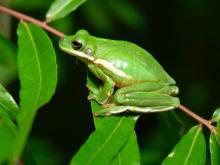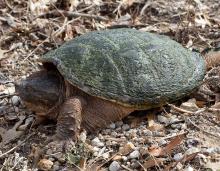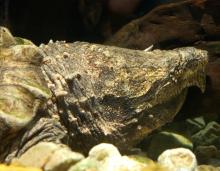Reptiles and Amphibians
Media

Species Types
Scientific Name
Anaxyrus cognatus
Description
Unlike other true toads in Missouri, the Great Plains toad has a raised hump between the eyes on the snout. Look for it along the Missouri River floodplain, from the Iowa border to about Hermann.
Media

Species Types
Scientific Name
Anaxyrus fowleri
Description
Fowler's toad is the common toad of gravel and sand bars along our many Ozark streams and rivers. It is also the most common toad in the Bootheel lowlands.
Media

Species Types
Scientific Name
Anaxyrus woodhousii woodhousii
Description
The Rocky Mountain toad has a number of irregular dark brown or black spots on the back and a white belly. It occurs in the Missouri River floodplain, mostly from the central to the far northwestern parts of the state.
Media

Species Types
Scientific Name
Spea bombifrons
Description
The plains spadefoot is a stout, toadlike amphibian with large, protruding eyes, vertically oval pupils, short legs, and large feet. There is a raised area between the eyes. It occurs in counties along the Missouri River.
Media

Species Types
Scientific Name
Hyla cinerea (syn. Dryophytes cinereus)
Description
The bright green treefrog hides perfectly among cattail leaves, where it rests until evening. Then it begins hunting for insects. In Missouri, it occurs mostly in the Bootheel.
Media

Species Types
Scientific Name
Acris blanchardi (formerly Acris crepitans blanchardi)
Description
Blanchard's cricket frog is a nonclimbing member of the treefrog family. It lacks the adhesive toe pads associated with treefrogs. It occurs statewide. The call is a metallic “gick, gick, gick.”
Media

Species Types
Scientific Name
Terrapene ornata
Description
The ornate box turtle usually has four hind toes. Its high-domed shell is usually smooth on top, lacks a ridge, and is brown with yellow lines. Look for it in grassy habitats.
Media

Species Types
Scientific Name
Chrysemys dorsalis
Description
The southern painted turtle is small and has a prominent yellow, orange, or red lengthwise stripe down the middle of the upper shell. In Missouri, this aquatic turtle is found only in the Bootheel region.
Media

Species Types
Scientific Name
Chelydra serpentina
Description
A large aquatic turtle with a big pointed head, long thick tail, and small lower shell, the eastern snapping turtle is common throughout the state, anywhere there is permanent water.
Media

Species Types
Scientific Name
Macrochelys temminckii
Description
In Missouri, alligator snapping turtles are protected, and it is illegal to harvest them. This species is totally aquatic and rarely leaves the water. In Missouri, it mainly occurs in the large rivers, sloughs, and oxbow lakes of our southern, southeastern, and eastern counties.
See Also
About Reptiles and Amphibians in Missouri
Missouri’s herptiles comprise 43 amphibians and 75 reptiles. Amphibians, including salamanders, toads, and frogs, are vertebrate animals that spend at least part of their life cycle in water. They usually have moist skin, lack scales or claws, and are ectothermal (cold-blooded), so they do not produce their own body heat the way birds and mammals do. Reptiles, including turtles, lizards, and snakes, are also vertebrates, and most are ectothermal, but unlike amphibians, reptiles have dry skin with scales, the ones with legs have claws, and they do not have to live part of their lives in water.





















